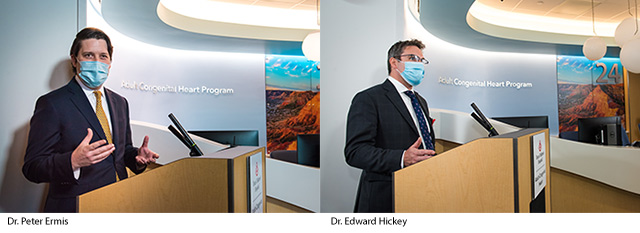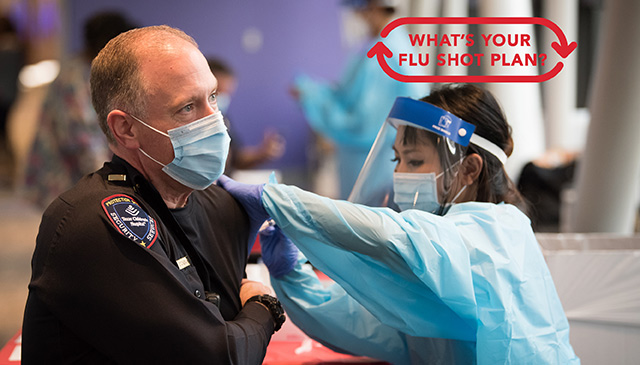
Denise Tanner-Brown shares creative ways we can celebrate the holidays safely this year while creating new memories with our families, friends and loved ones. Read more

Denise Tanner-Brown shares creative ways we can celebrate the holidays safely this year while creating new memories with our families, friends and loved ones. Read more

Since most of us have managed a household budget, this analogy will hit home.
The amount of money coming in matters. The amount of money going out matters even more.
The rate at which the money comes and goes is important.
And the ability to pay our bills on time is paramount.
It isn’t much different at Texas Children’s. Managing the organization’s resources is the work of several team members across multiple departments. Thanks to Epic Tapestry, the health care management system set to launch next summer, their work will be better informed, more efficient, more accurate and yield improved results.
For the third story in our series we are focusing on Finance and Claims, two departments that are directly connected to the management of the financial resources at the health plan.
Let’s take Finance first.
“We are thrilled to see Tapestry coming,” said Jenny Little, Vice President for Financial Services at Texas Children’s. “This new system will introduce automation to several functions that are currently manual. This will help free up the team’s time for more in-depth analysis to inform strategic decision-making. It will also help to secure the control environment of the Health Plan, which improves our accuracy and reputation with the State, our members and our peers.”
In addition to automation, Little says that Tapestry will provide more data and insights on how the health plan and the hospital can work together to propel our mission. This will not only inform and improve our financial performance, but it will also inform how we can truly help our members and patients.
“We’re talking about an ability to work more efficiently, and also have better outcomes with the work that we do. It doesn’t get any better than that. Because of this, we are hoping there is also increased job satisfaction for our employees,” Little said.
All of this couldn’t be done without the amazing Health Plan leadership team, including Ryan Thompson, Director of Finance and Christina Milan, Assistant Director of Finance. They are both leading the transition and representing Finance on this important transition.
Now, let’s return to our household budget analogy. Remember when we talked about paying our bills? This is where the Claims department comes in.
After our providers take care of our members, they submit a bill for their services – a claim. We accept or deny these claims based on a set of criteria. If we accept the claim, we pay for their services.
The Claims department is already doing an extraordinary job following a restructure and reignition by Director April Riggs. Under Riggs’ leadership, the department is performing better than ever.
“But we never rest on our laurels,” Riggs said. “And we too are excited to see Tapestry coming. Our workflow will significantly improve after the implementation. It will ensure that our systems are robust enough to guarantee the accurate and timely payment of claims.”
Riggs added that the pandemic has introduced new challenges, such as a need to process more claims for telemedicine and telehealth services. Her team has made the adjustments and Tapestry will be a great help if further adjustments are needed in the future.
But why is now the right time?
“COVID-19 showed Texas Children’s just how valuable the health plan is to the entire system,” said Little. “While the pandemic caused the hospital to lose money, the health plan made money – $95 million. In actuality, the health plan really saved us. Any investment in the health plan is an investment in the entire organization.”
Little added that having Mark Mullarkey at the helm during this time is significant. Mullarkey, who is the president of Texas Children’s Health Plan and an Executive Vice President for Texas Children’s, has a strong reputation for his focus on operational efficiency and results.
“We now have the right leader in place,” said Little. “And we know that makes all the difference.”
Missed the other stories in our series? Check them out!
The first one was all about Care Coordination and the Healthy Planet module.
The second one was all about Member Services.

Today is the last day for 2021 Benefits Annual Enrollment! Please make your elections safely and conveniently online at www.texaschildrensbenefits.org by midnight tonight.
If you do not plan to have medical, dental and vision benefits through Texas Children’s, please log into our Benefits website and waive coverage. Otherwise, your current elections will carry over to 2021.
To participate in either the Healthcare or Dependent Care Flexible Spending Accounts (FSAs) in 2021, you must make an election during Annual Enrollment.
Thank you for participating!

On November 4, Texas Children’s Heart Center® leaders, alongside President & CEO Mark A. Wallace, gathered for an intimate ribbon cutting ceremony to commemorate the opening of the hospital’s first-of-its-kind facility for adults with congenital heart disease.
The 27,000-square-foot space, situated on the 24th floor of Texas Children’s Lester and Sue Smith Legacy Tower, includes a 16-bed inpatient unit, outpatient clinic, cardiac rehab gym, diagnostics lab and more.
“This is the #1 Heart Center in the world and it just got even better,” Wallace said. “Only at Texas Children’s is this possible, especially during this time and this era.”
That same day, the outpatient clinic saw its first patients in the new, state-of-the-art space.
“Texas Children’s has always been innovative in the treatment of congenital heart disease with Drs. Denton Cooley, Dan McNamara, Edward Singleton and others paving the way for this population that’s increased over time,” Dr. Peter Ermis, medical director of the Adult Congenital Heart (ACH) Program, said. “We’re picking up their mantle and carrying on their legacy, and I think it’s appropriate that we’re doing so in the Lester and Sue Smith Legacy Tower. We’re seeing some of those exact same patients they cared for as kids.”
The new facility is a game changer for this patient population. About 1.6 million adults currently live with congenital heart disease in the United States, but they are a rare patient within an adult hospital environment. Treatment for these patients within an adult hospital does not allow them to get the unique care they need. In a children’s hospital, the majority of cardiac patients have congenital heart disease, and these adults with congenital heart disease are not as unique.
“Until now, patients have been managed somewhat ad hoc – either in pediatric environments or in adult environments with teams that are not particularly experienced in managing congenital heart defects,” Dr. Ed Hickey, surgical director of the ACH Program, said. “That’s all changing here at Texas Children’s. This vision that we’ve realized has come from the top down. Mr. Wallace himself realized that it’s our responsibility to care for these patients irrespective of age, complexity or location.”
The two leaders are excited for the future as Texas Children’s combines the incredible facility, dedicated team and resources to provide the best possible care to adults with congenital heart disease.
The inpatient unit on the 24th floor will open in January 2021. To learn more, visit texaschildrens.org/ACH.

With COVID-19 spiking across the country, celebrating the upcoming holidays in a safe manner will be of enormous importance in keeping ourselves and our families safe during this period of heightened activity. Although social distancing from friends and family can be difficult – especially during the holiday months – it is absolutely critical that we continue the practices that have helped to mitigate the spread of this virus. To help you prepare, please take a moment to review the following holiday guidance from both Texas Children’s and the Centers for Disease Control and Prevention (CDC).
Please remember that masks are required upon entrance to a Texas Children’s facility and should be worn at all times, including in parking garages, shuttle stops and while riding the shuttle. A mask should be worn as soon as you step out of your personal mode of transportation before entering a building, and the hospital-issued mask should remain on as you leave the building until you reach your personal mode of transportation. Masks should also be worn at all times in shared office spaces, including inside cubicles or at desks that are more than six feet apart. Individuals sitting in cubicles or shared workspaces may remove masks to eat or drink if they are the only ones present. As soon as the individual is finished eating and/or drinking, the mask must be placed back on. Keep in mind that respite rooms and private rooms are available for individuals to unmask and rest in solitude, as needed.
Lastly, always practice social distancing guidelines to ensure six feet of space between people are in place at all times. This includes in elevators, common areas and while riding the shuttle. Shared spaces, such as breakrooms and conference rooms, have limited capacity (posted online and on doors) in order to maintain social distancing.
Thank you for leading the way and setting an example for your team members, our patients, their families, your families and our community.

Texas Children’s, in partnership with Baylor College of Medicine, is saving the lives of children and women across the globe.
A network of physicians, fellows and residents provide much-needed clinical support as well as training and academic leadership to underserved communities in 18 nations in Africa, Romania, Papua New Guinea and Latin America. These global efforts began in 1999 with the creation of the Baylor College of Medicine International Pediatric AIDS Initiative at Texas Children’s Hospital, also known as BIPAI.
Under the initiative, the first Children’s Clinical Center of Excellence opened its doors in Constanta, Romania. Today, there are 14 such centers and satellite centers in eight countries across the world. The care provided at these centers has saved a generation of young people with HIV/AIDS and has given BIPAI a model from which to expand its services to both children and women.
The series of stories you will see on Connect over the next few months will talk about why Texas Children’s started a global health program and why it is so important for us to maintain it, grow it and continue to support it.
The series will highlight our efforts in Malawi because members of the Corporate Communications team traveled there last summer to gather stories, video and photographs in order to better educate our internal and external audiences about our efforts overseas.
Since then, the COVID-19 pandemic has stopped travel to these areas and many of the others we serve, but Texas Children’s remains dedicated to our global health efforts and still has many clinicians on the ground across the globe. We are moving forward with capital projects that were in the works prior to the pandemic and are offering support services in any and all ways possible both to help the people in these countries overcome the pandemic and to maintain the progress that’s been made in these areas over the past 20 years.
“It’s imperative we protect the gains we’ve made,” said Michael Mizwa, chief executive officer of BIPAI. “COVID-19 has the potential to wipe out years of work in areas where we are seeing significant gains. We cannot give up on the children and women in these countries now. They need us more than ever.”
Tune in next week to learn more about when, where and how Texas Children’s global health initiatives began and why they are making such a positive impact on the children and women they serve.

As of November 13, 73.4 percent of our team members are vaccinated against the flu. Vaccination events are still available across the organization. Read more